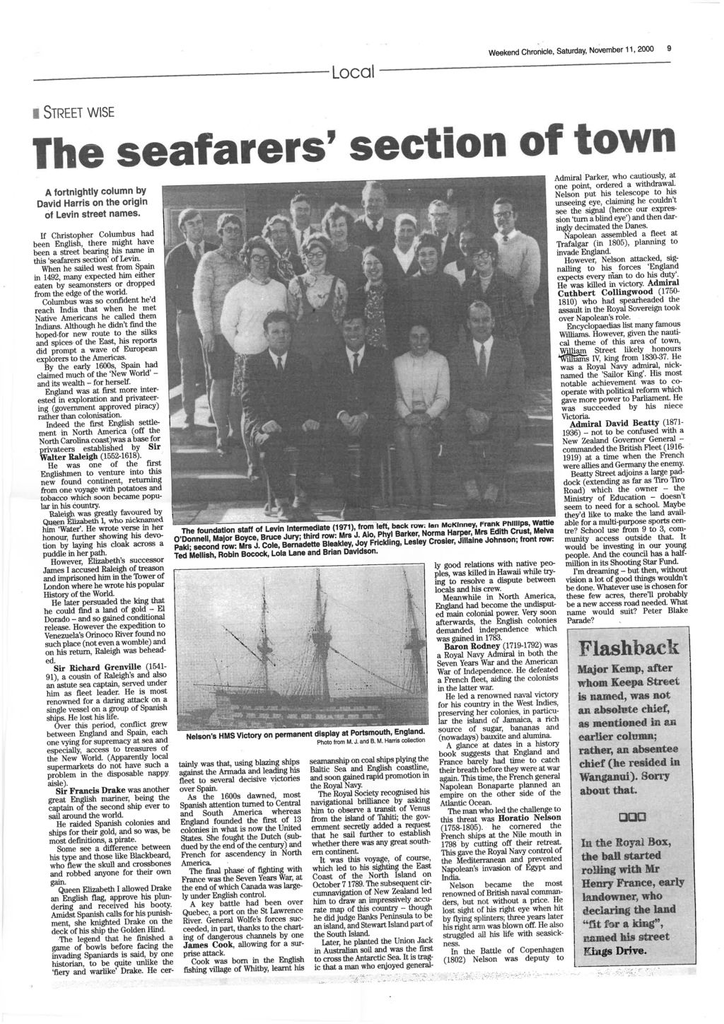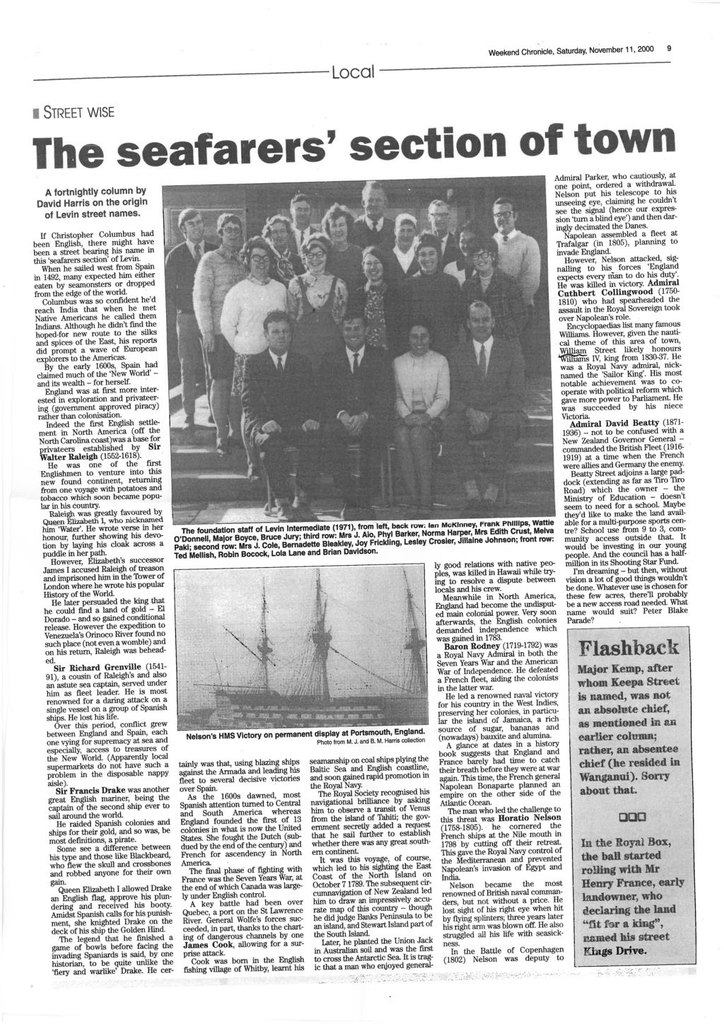Seafarers' section of town
- Description
Photo at left: The foundation staff at Levin Intermediate (1971).

From left, back row: Ian McKinney, Frank Phillips, Wattie O'Donnell, Major Boyce, Bruce Jury; third row: Mrs J. Aio, Phyl Barker, Norma Harper, Mrs Edith Crust, Melva Apki; second row: Mrs J. Cole, Bernadette Bleakley, Joy Frickling, Lesley Crosier, Jillaine Johnston; front row: Ted Mellish, Robin Bocock, Lola Lane and Brian Davidson.
From photo published in the Weekend Chronicle 11 November 2000.
If Christopher Columbus had been English, there might have been a street bearing his name in this 'seafarers section' of Levin.
When he sailed west from Spain in 1492, many expected him either eaten by seamonsters or dropped from the edge of the world.
Columbus was so confident he'd reach India that when he met Native Americans he called them Indians. Although he didn't find the hoped-for new route to the silks and spices of the East, his reports did prompt a wave of European explorers to the Americas.
By the early 1600s, Spain had claimed much of the 'New World' - and its wealth - for herself.
England was at first more interested in exploration and privateering (government approved piracy) rather than colonisation.
Indeed the rust English settlement in North America (off the North Carolina coast)was a base for privateers established by Sir Walter Raleigh (1552-1618).
He was one of the first Englishmen to venture into this new found continent, returning from one voyage with potatoes and tobacco which soon became popular in his country.
Raleigh was greatly favoured by Queen Elizabeth I, who nicknamed him 'Water'. He wrote verse in her honour, further showing his devotion by laying his cloak across a puddle in her path.
However, Elizabeth's successor James I accused Raleigh of treason and imprisoned him in the Tower of London where he wrote his popular History of the World.
He later persuaded the king that he could find a land of gold - El Dorado - and so gained conditional release. However the expedition to Venezuela's Orinoco River found no such place (not even a womble) and on his return, Raleigh was beheaded.
Sir Richard Grenville (1541- 91), a cousin of Raleigh's and also an astute sea captain, served under him as fleet leader. He is most renowned for a daring attack on a single vessel on a group of Spanish ships. He lost his life.
Over this period, conflict grew between England and Spain, each one vying for supremacy at sea and especially, access to treasures of the New World. (Apparently local supermarkets do not have such a problem in the disposable nappy aisle).
Sir Francis Drake was another great English mariner, being the captain of the second ship ever to sail around the world.
He raided Spanish colonies and ships for their gold, and so was, by most definitions, a pirate.
Some see a difference between his type and those like Blackbeard, who flew the skull and crossbones and robbed anyone for their own gain.
Queen Elizabeth I allowed Drake an English flag, approved his plundering and received his booty. Amidst Spanish calls for his punishment, she knighted Drake on the deck of his ship the Golden Hind.
The legend that he finished a game of bowls before facing the invading Spaniards is said, by one historian, to be quite unlike the 'fiery and warlike' Drake. He certainly was that, using blazing ships against the Armada and leading his fleet to several decisive victories over Spain.
As the 1600s dawned, most Spanish attention turned to Central and South America whereas England founded the first of 13 colonies in what is now the United States. She fought the Dutch (subdued by the end of the century) and French for ascendency in North America.
The final phase of fighting with France was the Seven Years War, at the end of which Canada was largely under English control.
A key battle had been over Quebec, a port on the St Lawrence River. General Wolfe's forces succeeded, in part, thanks to the charting of dangerous channels by one James Cook, allowing for a surprise attack.
Cook was born in the English fishing village of Whitby, learnt his seamanship on coal ships plying the Baltic Sea and English coastline, and soon gained rapid promotion in the Royal Navy
The Royal Society recognised his navigational brilliance by asking him to observe a transit of Venus from the island of Tahiti; the government secretly added a request that he sail farther to establish whether there was any great southern continent.
It was this voyage, of course, which led to his sighting the East Coast of the North Island on October 7 1789. The subsequent circumnavigation of New Zealand led him to draw an impressively accurate map of this country - though he did judge Banks Peninsula to be an island, and Stewart Island part of the South Island.
Later, he planted the Union Jack in Australian soil and was the first to cross the Antarctic Sea. It is tragic that a man who enjoyed generally good relations with native peoples, was killed in Hawaii while trying to resolve a dispute between locals and his crew.
Meanwhile in North America, England had become the undisputed main colonial power. Very soon afterwards, the English colonies demanded independence which was gained in 1783.
Baron Rodney (1719-1792) was a Royal Navy Admiral in both the Seven Years War and the American War of Independence. He defeated a French fleet, aiding the colonists in the latter war.
He led a renowned naval victory for his country in the West Indies, preserving her colonies, in particular the island of Jamaica, a rich source of sugar, bananas and (nowadays) bauxite and alumina.
A glance at dates in a history book suggests that England and France barely had time to catch their breath before they were at war again. This time, the French general Napolean Bonaparte planned an empire on the other side of the Atlantic Ocean.
The man who led the challenge to this threat was Horatio Nelson (1758-1805). He cornered the French ships at the Nile mouth in 1798 by cutting off their retreat. This gave the Royal Navy control of the Mediterranean and prevented Napolean's invasion of Egypt and India.
 Nelson became the most renowned of British naval commanders, but not without a price. He lost sight of his right eye when hit by flying splinters; three years later his right arm was blown off. He also struggled all his life with seasickness.
Nelson became the most renowned of British naval commanders, but not without a price. He lost sight of his right eye when hit by flying splinters; three years later his right arm was blown off. He also struggled all his life with seasickness.In the Battle of Copenhagen (1802) Nelson was deputy to Admiral Parker, who cautiously, at one point, ordered a withdrawal. Nelson put his telescope to his unseeing eye, claiming he couldn't see the signal (hence our expression 'turn a blind eye') and then daringly decimated the Danes.
Napolean assembled a fleet at Trafalgar (in 1805), planning to invade England.
However, Nelson attacked, signalling to his forces 'England expects every than to do his duty'. He was killed in victory. Admiral Cuthbert Collingwood (1750- 1810) who had spearheaded the assault in the Royal Sovereign took over Napolean's role.
Encyclopaedias list many famous Williams. However, given the nautical theme of this area of town, ,William Street likely honours William IV, king from 1830-37. He was a Royal Navy admiral, nick-named the 'Sailor King'. His most notable achievement was to co-operate with political reform which gave more power to Parliament. He was succeeded by his niece Victoria.
Admiral David Beatty (1871- 1936) - not to be confused with a New Zealand Governor General - commanded the British Fleet (1916- 1919) at a time when the French were allies and Germany the enemy.
Beatty Street adjoins a large paddock (extending as far as Tiro Tiro Road) which the owner - the Ministry of Education - doesn't seem to need for a school. Maybe they'd like to make the land avail-able for a multi-purpose sports centre? School use from 9 to 3, community access outside that. It would be investing in our young people. And the council has a half- million in its Shooting Star Fund.
I'm dreaming - but then, without vision a lot of good things wouldn't be done. Whatever use is chosen for these few acres, there'll probably be a new access road needed. What name would suit? Peter Blake Parade?
F1ashback
Major Kemp, after whom Keepa Street is named, was not an absolute chief, as mentioned in an earlier column; rather, an absentee chief (he resided in Wanganui). Sorry about that.
Identification
Taxonomy
- Community Tags


